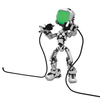« Previous 1 2 3 4 Next »
OS10 and Dell's open networking offensive
Freedom, as in OS10
Easy Automation
Another big problem for modern workflows is often encountered in the static configurations associated with classical network hardware. Hardware by established vendors typically have just a command line or maybe a proprietary interface specified by the provider to create new configurations. This setup can be difficult to bring in line with today's typical DevOps workflows: The assumption here is that it might be necessary to reconfigure (or configure from scratch) any server at any time in an automated process. A standard Linux like OS10 makes this easy to achieve: Whether Puppet, Chef, or Ansible, switches with OS10 can be edited easily from within your choice of automation solution.
Dell explicitly highlights this fact in the technical description of the OS10 base module [3]. There are even workflows in which a new switch, after being installed in the rack, is installed automatically without an admin having to log in or otherwise intervene manually. This feat is difficult to achieve with old-fashioned networking hardware. Dell keeps its promise of a universal switch operating system that integrates with DevOps workflows to a T.
Operable Cloud Software
Precisely because switches are servers with many network cards, it is possible to run cloud components directly on the switches themselves instead of on individual servers. All common cloud approaches envisage network nodes, which provide VMs in the cloud with external connectivity and take care of VXLAN tunneling and packet separation. Thus far, it has been customary in clouds to handle these tasks either with VMS running on the hosts or to create separate network nodes that perform no other task.
Theoretically there's nothing to prevent you right now from installing and operating the network components (e.g., from OpenStack) on a switch with the appropriate resources – RAM and CPU, in particular. Setups of this kind have not been able to assert themselves so far, not least because the popular SDN solutions for clouds, such as OpenStack, can hardly make meaningful use of the extra information on the switches.
Thanks to solutions like Cumulus or OS10, it is only a matter of time until the SDN manufacturers identify generic switches as target platforms and integrate matching functionality into their solutions. In any case, OS10 is ready for a setup of this kind.
CPS for a Classic Approach
Dell sees OS10 not only as a switch operating system for companies that require maximum flexibility in managing their network hardware, but also as a universal system that offers a choice between flexibility and off-the-shelf solutions. CPS is part of this approach: It is a programming interface used by Dell to add modules retroactively and thus enhance the switch's feature set. It is also implemented as an OS10 Linux system that also accesses the SAI layer directly in the background.
At least a couple of small dents appear in Dell's brave, new, dynamic world at this point, because several important features of the switch hardware can be configured only via the CPS interface and not the Linux command line. These features include port monitoring at the hardware level, quality of service, and access control lists. Dell has at least released detailed documentation for CPS and the matching API and peppered it with many examples. Additionally, bindings for the main script language, Python, exist. If you want to use one of the CPS-only features, you can do so via the CPS interface without having to pay money to Dell (Figure 5).
 Figure 5: Python integration is available for CPS, meaning you can read the MAC table of the switch with a Python script, as shown here.
Figure 5: Python integration is available for CPS, meaning you can read the MAC table of the switch with a Python script, as shown here.
Clearly this was hardly likely Dell's original intent: After all, CPS is aimed specifically at companies who want L2 or L3 functionality without having to worry about the actual implementation on the switch. CPS is also Dell's answer to the question of how third-party manufacturers can make their products fit for use on OS10 switches: by using CPS and handling system queries via the local API.
The first versions of OS10 fair poorly compared with competitors like Cumulus, because they do not yet support all the features offered by competitors. However, with CPS, Dell likely will try to catch up in the feature race.
« Previous 1 2 3 4 Next »
Buy this article as PDF
(incl. VAT)
Buy ADMIN Magazine
Subscribe to our ADMIN Newsletters
Subscribe to our Linux Newsletters
Find Linux and Open Source Jobs
Most Popular
Support Our Work
ADMIN content is made possible with support from readers like you. Please consider contributing when you've found an article to be beneficial.






